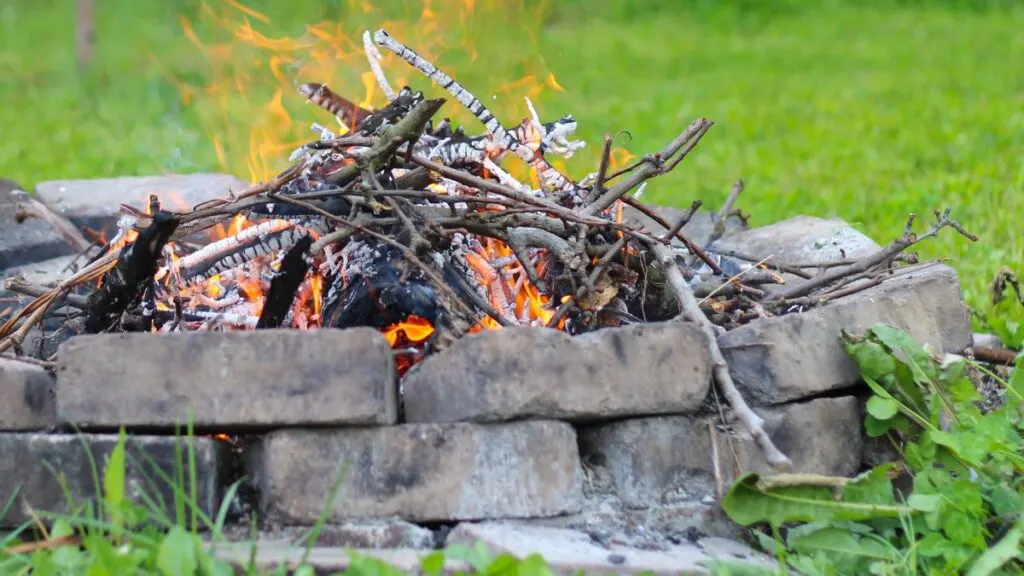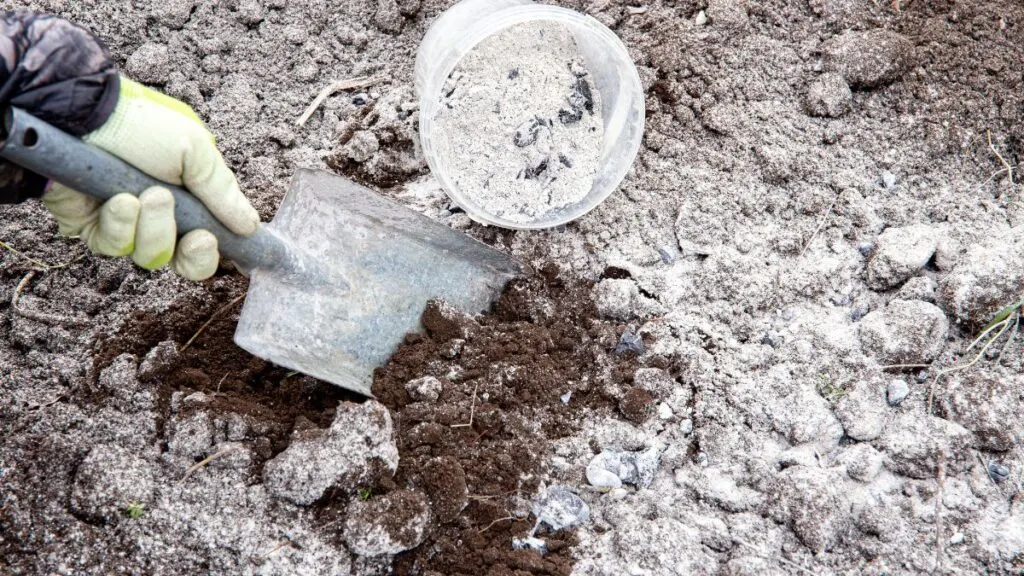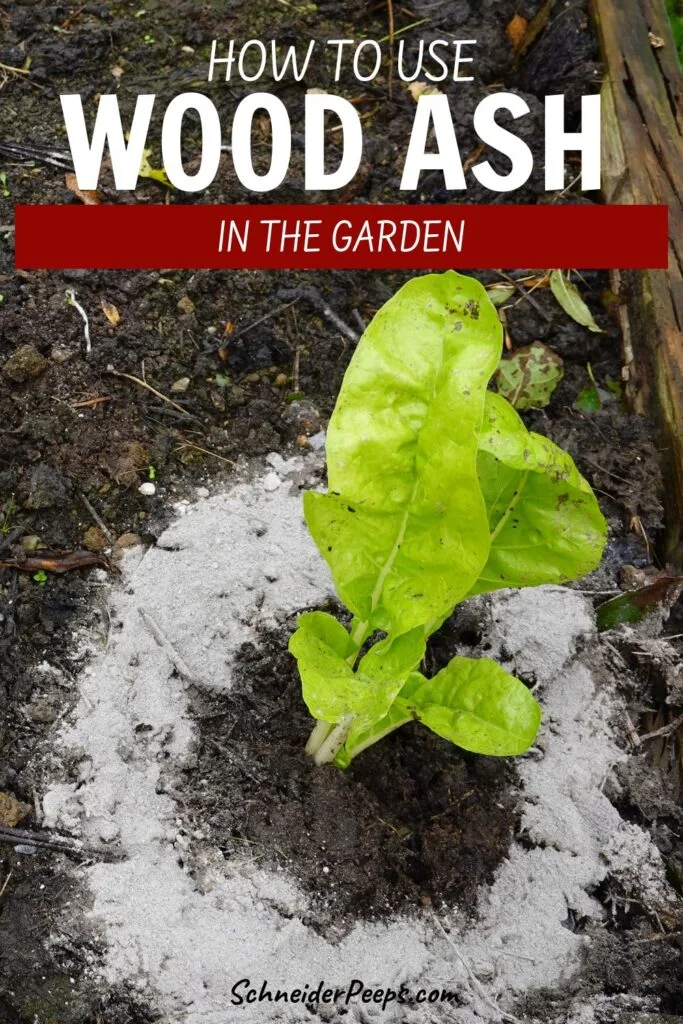I first learned about using wood ashes in my garden from a friend from Kenya. We were walking in the garden and noticed that the kale was infested with aphids (which often happens in the heat of the summer around here). I’m always leery of using chemicals so i usually end up doing nothing. I asked her what they used in the garden in her village and she said, “Wood ash.”
And that was when I began using wood ashes in the garden.

What is Wood Ash and Where to Get It
Wood ash is exactly what it sounds like it is…ashes from burned wood. It’s full of nutrients that can be used as fertilizer in the vegetable garden, on fruit trees, and even the lawn.
While you can purchase wood ash at your local garden center, a better place to get it is from any wood burning source in your home such as…
- fireplace ashes
- wood burning stove
- outdoor fire pit
- smoker
- brush burn
Unless you’re trying to raise the ph of very acidic soil, you really don’t need a lot of wood ash for the garden. So, don’t overlook small wood burners like the smoker. Over time those small amounts will add up.
If you want wood ash that has the most nutrients, the type of wood burned matters. Hardwood has more nutrients than wood from softwood, therefore, ashes of hardwoods will have more nutrients than ashes of softwoods. But all wood ash has is a good source of potassium and other trace elements.

Benefits Using Wood Ashes in the Garden
- Rich in Minerals: Wood ash is a rich source of trace elements such as calcium carbonate, potassium, magnesium. These nutrients are vital for plant growth, flowering, and fruiting.
- Very Alkaline: Wood ash has alkaline properties, making it an excellent amendment for acidic soils. If your vegetable garden’s soil is too acidic, adding wood ash can help balance the pH of the soil. Just know that it will take about twice as much wood ash as it does agricultural lime to change the soil pH. So, if you test your garden soil and it recommends 20 pounds of lime be added, you’ll need 40-50 pounds of wood ash.
- Natural Pest Repellent: Wood ash can act as a natural deterrent for certain pests. Sprinkling a thin layer around plants can help keep pests at bay without resorting to chemical pesticides.
The main nutrient in wood ash is potassium, the third number listed on a fertilizer analysis. It’s left behind in the form of “potash” (potassium bicarbonate). Adding wood ash to a garden plot also adds calcium and magnesium to the soil, similar to applying lime.
University of Georgia
How to Use Wood Ash in the Garden
While wood ash is really great to use in the home garden, it can cause trouble if over used or used on plants that like acidity.
Test and Amend the Soil
It’s recommended that before applying wood ash, you do a soil test to check the soil’s pH. This will help you determine whether your garden needs a pH adjustment and how much wood ash is required. If you’re trying to amend the soil, then you definitely need a soil test. You can send a soil sample off to a lab or do an at-home soil test. However, if you’re using wood ash in small quantities for things like pest control, a soil test is not necessary (in my opinion.)
Like most other soil amendments, it’s best to use wood ash in the late winter or early spring before planting. As a soil amendment, wood ash works more quickly than lime and only needs about a month to work. So, if you’ve missed the window for using agricultural lime as an amendment, you can use wood ash.
When spreading wood ash on the soil, try to spread it on moist soil so it stays where you put it. If the soil is dry, gently water it after spreading the ash.
As a general rule, don’t use wood ash as an amendment for soil that has a pH of 6.5 or higher as it will make the soil too alkaline for most fruits and vegetables. That being said, if you’re growing something that needs more alkaline soil, using wood ash is a good thing.
Wood ash can also be used along with other organic matter to help break up clay soil.
Sprinkle, Don’t Dump
Sprinkling the wood ash on the soil or plants ensures that you won’t get it concentrated in one area and kill the plants in that area. If you’re treating a large area be sure to use a rake to evenly spread the wood ashes over the soil.
Application Rates
Wood ash fertilizer should be used according to the rates below to raise the ph level of the soil.
- For gardens and flower beds apply 15 to 20 pounds of wood ash per 1000 square feet. This about the amount of finished ash you can get from burning one cord of wood.
- For rose bushes and fruit bushes apply 1/2 to 1 pound of wood ash around the base of the plant.
- For individual plants apply wood ash around the base of the plant to no more than 1/2-inch thick
- For fruit trees apply wood ash around the base of the plant to no more than 1-inch thick
Plants that Benefit from Wood Ash
Some plants thrive in an alkaline environment. So don’t be shy about using wood ash on asparagus, brassicas (cabbage, cauliflower, brussels sprouts), pine trees, tomatoes, lilacs and roses.
Add to the Compost Pile
Wood ash can be added directly to the compost heap. It will help control the acidity of the compost and you’re more likely to end up with a compost that is near neutral on the pH scale. It not only enriches the compost with valuable minerals but also ensures a more gradual release of nutrients into the soil.
Wood ashes can also help with odors that sometimes happen in a compost pile as it’s breaking down organic matter. And it helps with the texture and tilth of the finished compost.
Natural Pest and Disease Control
There are several ways to use wood ash for pest and disease control.
- Make a ring of wood ash around the base of plants to keep slugs away.
- Wood ash can be sprinkled on plants to deter and kill insects such as aphids. Try to be careful to not sprinkle wood ash into the blooms where bees and other beneficial insects will be visiting.
- Since wood ash is an alkaline, it can help control fungus such as powdery mildew. We keep wood ash in an old parmesan cheese container and sprinkle it at the first sign of powdery mildew on our squash. It doesn’t cure it all, but it certainly helps.
- If your tomatoes have blossom end rot, mix small amounts of wood ash in the soil around the plants. Wood ash has a good about of calcium which will help with the blossom end rot.
Don’t Use on Acid-Loving Plants
Avoid using wood ash on plants that like acid soil such as blueberries, cranberries, sweet potatoes and pecans. Also, don’t use wood ash on regular potatoes as it can encourage potato scab.
Not for Seedlings
Don’t use straight wood ash on seedlings because it has too much salt for them. If you’ve made compost with wood ash, that is fine to use on seedlings.
Safely Using Wood Ash
Wood ash should be completely cooled before using or storing. Once it’s cooled you can sift out any unburned wood chunks and then either use the ash or store it for later.
When using wood ash (or any fine powder) you should wear a dust mask to keep from inhaling the particles. Its a good ideas to wear gloves, especially if you plan on touching the ash with your hands. We always think about acidic things burning but alkaline things can also leave burn.
Also, if you’re unsure about what was actually burned, don’t use the ashes. You want ashes from just untreated wood – no charcoal or briquettes, no plastic or styrofoam, no fake wood from the fire place, no treated or painted wood.

Heavy Metals in Wood Ash
Properly sourced wood ash rarely has heavy metals in it. Metals such as cadmium and lead can sometimes be present in wood ash, however, the rise in pH in the soil from using wood ash will often keep the plants from taking up the heavy metals. That being said, if you’re concerned about the wood ash you’re using you can have it tested.
Source: University of Wisconsin-Madison
Storing Wood Ash
If you’re not going to use wood ash right away, you can store it in a metal container. If you have lots of ash, for instance from wood-burning stoves, you can use a galvanized trash can. If you don’t have much, you can use a galvanized bucket with a lid, which is what we do. Just make sure the ash is cool before you put it in the bucket.
The main thing is that the wood ash needs to stay dry. If you leave it out in the open, the nutrients can leach out when it rains.
More Practical Uses for Wood Ash
As mentioned before wood ashes are very alkaline and if you remember anything from your high school chemistry class, hopefully you remember that alkaline substances (also called base) can cause chemical burns, just like acidic substances. The further substances are away from neutral (ph 7) the harsher they are. There is certainly not reason to be scared to use wood as in a variety of ways, but you do need to be prudent.
Because it’s alkaline, it makes a very good household cleaner. Mix with a little water to scrub pots and pans, sinks, bathtubs, toilets, glass and silverware. Anywhere you’d use something like Bar Keeper’s Friend.
Lye is extracted from wood ashes and is essential for soap making.
It can be be sprinkled on oil spills to help with clean up.
Wood ash can be sued as a roach repellant. I wouldn’t use it in my home but we do use it in the hen house.
Add wood ash to your chicken’s dust bath area to help control mites, fleas and other insects.
Wood ash can also be to preserve food – seeds, tomatoes, and even cheese.
In a pinch, it can be used for wound care and to help relive the itch from insect bites.


Annette
Saturday 19th of June 2021
My grandmother used wood ashes sprinkled thru an old hose (think panty hose). On beans to get rid of beetles. The mixture was a peck of wood ashes filtered thru a wire strainer to a half cup of salt (or I quart to a tablespoon for my much smaller garden). It works and I just set up my recipe today to be ready.
Angi Schneider
Sunday 20th of June 2021
Thanks for the tip!
Burn Barrel 101: Why You Need One on Your Homestead
Tuesday 24th of November 2020
[…] is one of those times I don’t condone composting. Ash is, in moderation, great for the garden, but unless you’re burning straight wood in your burn barrel… maybe not this time. I […]
Sharad Sharma
Friday 24th of August 2018
Yes I use ash on my plants. It's a very old technique followed by se people here in india. It's too popular. Many people are using ash left from burning cow dung cakes. I have collected ash from burning dried leaves of neem tree. This time I have used it on my plants at terrace and results are too good I can suggest one more item for farming which is self made and costless. We call it jeevamrut. It's a good fertilizer.
Angi Schneider
Friday 24th of August 2018
Hi Sharad, it's really great that your people are really utilizing what's available for fertilizer. Here in the states I think most of us (myself included) don't realize how wonderful those fertilizers are and instead spend money on purchased fertilizer and pesticides. I looked up jeevamrut and it looks amazing - I'll have to see if I can locate some local cow dung to try some. Thanks so much for sharing what you do!
Simone clark
Sunday 7th of May 2017
What is the difference between wood ash and sulphate of potash in its composition and effects on vegetables?
Angi Schneider
Monday 8th of May 2017
The main differences are going to be cost and precision. If you use ashes from wood you burned, it's free but you won't know the exact percentage of potash or potassium in it. If that doesn't bother you to not have that precision, I would just use wood ash. On the other hand sulphate of potash costs money but the bag will tell you what percentage of potash and potassium are in it. If you need that specificity or don't have access to wood ash, then use sulphate of potash. The effects of using either one are going to be very similar.
Elaine
Friday 7th of April 2017
Even in an alkaline soil wood ash is great for spring flowering bulbs ..tulips,daffodils, crocus..
Angi Schneider
Friday 7th of April 2017
Thanks for sharing, Elaine. I'm not much of a flower gardener and didn't know that.